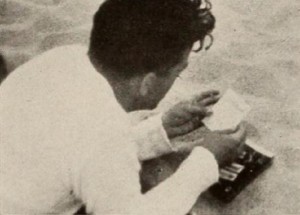
"Take a man who wants to play golf and his wife who wishes to see the sights on a family vacation and you have the simple plot of Nantucket Turnabout. Richard Elms treats the idea with a freshness, however, that lifts it from the usual vacation film class. Through the mechanism of the wife's desire to visit historical places, some lovely views of Nantucket are logically inserted in the film, while the husband wearily tags after her as his prepayment for a chance to play golf. The eventual golf game ends with the wife, fresh after her sight seeing, winning easily, while the exhausted husband repeatedly drives to the rough, far into the final sunset." Movie Makers, Dec. 1945, 496.
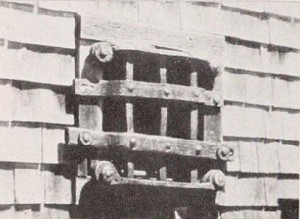
"In filming Nantucket, A Chapter from Early America, Russell T. Pansie chose a happy subject for Kodachrome — the weatherbeaten grays and pastel colors of the ancient buildings of Nantucket. Most color films are made with an effort to present colors as brilliantly as possible, but this picture is a delightful exception, and it is a notable example of the versatility of color film in the hands of a competent cameraman. In Nantucket, A Chapter from Early America, we see the orderly streets of the island, the historic buildings that date from the early Eighteenth Century, the mansions built by the prosperous sea captains of the Nineteenth Century and we glimpse the island's natural charm. But, in the brief footage that he wisely allowed himself, the cameraman has achieved more than an architectural study; he has reproduced the atmosphere of life as it was lived in the past." Movie Makers, Dec. 1943, 474.
"Narraburra is a slick piece of drama telling of the misfortune encountered by a prospector in the wilds of Australia who is thrown from his horse and breaks his leg. While his friends go for aid, a colony of meat ants find him and he knows that in a short while they will eat his flesh until he dies. How he keeps the ants from achieving their objective provides good cinema fare" PSA Journal, Sept. 1966, 35.

"In Narrow Gauge Kingdom Roger H. Klatt presents an ambitious and highly successful documentary study of the rapidly vanishing narrow gauge railroads of the Far West—and of Colorado in particular. Excellently photographed and edited, Narrow Gauge Kingdom gives rewarding evidence of high-caliber research carried out by a genuine railroad enthusiast. Both picture-wise and in well-delivered narrative, Mr. Klatt has delved deep into the flavor of his subject, producing a film which, despite is length, is interesting throughout and of lasting historical significance. A newcomer to the Ten Best competitions Mr. Klatt has used the medium of the motion picture with rare competence. Not only has he effectively pinned down the dramatic possibilities inherent in his subject, but he has utilized the mountain background of Colorado to fine advantage. Apparently neutral between the proponents of magnetic stripe or tape recording, Mr. Klatt has used both, skillfully putting the narration and railroading sound effects on magnetic stripe and and effectively indigenous guitar accompaniment on a separate tape!" PSA Journal, Jan. 1955, 48.
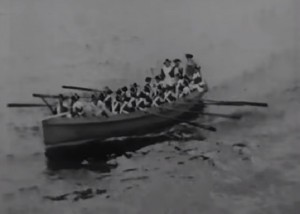
"The subject of 'Nation Builders'—the history of Australia—is without doubt the most ambitious ever undertaken by any amateur filmer. The fact that the project was successful is in itself a tribute to Sherlock's skill. Granted that in connection with the 150th anniversary of his nation's founding there were pageants re-enacting historic events and an opportunity for an alter filmster to photograph them: but how many times have not other amateurs scored dismal failures trying the same thing? Filming such a pageant, it is all too easy to capture only the impression of history actually happening. The twentieth century background which must so often have been just beyond the camera-lines was never permitted to intrude upon his eighteenth and nineteenth century action." American Cinematographer, Feb. 1939, 61.
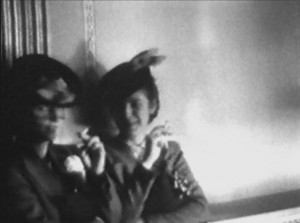
"Record of a film society screening at the Stanley Theatre on Granville Street, Vancouver. Includes shots of the "concert" program; scenes outside the theatre before and after the show and at intermission; audience in the lobby; movie scenes shot off the screen from the auditorium; unidentified man introducing films. Oscar Burritt is seen outside the theatre at intermission, and film society members Dorothy Fowler and Moira Armour are glimpsed briefly in the lobby." (D.J. Duffy)
"Wayne Mitchell, a former Ranger in the National Park Service acquaints the audience with a few of the Ranger's many jobs. Filmed in the Sequoia National Park, with Mrs. Mitchell as co-producer, this excellent film includes a hair-raising fire sequence which was finally obtained only after the Mitchells had expended considerable time and energy chasing forest fire reports from San Diego to Sequoia. Invariably upon arrival, they would find it to be only a brush fire or in a spot inaccessible for filming. The film demonstrates their eventual successes." PSA Journal, Dec. 1955, 36.

"Everybody has religion of some kind, of some creed. But to try to portray it in motion pictures takes courage in any language your faith. In The Nativity, Sal Pizzo has picture the story of the birth of Christ with unerring good taste, complete reverence and warm beauty. In it he follows old Biblical paintings as a pattern, but he animates these tableaux in a natural manner. One might wish, in fact, that he had followed them even further and used lighting to suggest halos around Mother and Babe. The long-shot model of the town of Bethlehem is believable. The bearded faces of the innkeepers are believable and, a great achievement, the costumes of the opulent kings are believable. The acting is handled with admirable restraint, the story being carried by the words of familiar Christian carols of background music. Especially well-staged are the scenes of the shepherds around their fires and of the Magi as they present their gifts to the Child in the humble manger. Mr. Pizzo and his associates have planned and executed a picture on a subject that few if any would dare to attempt. They are to be congratulated on their tender and moving triumph" PSA Journal, Jan. 1955, 50.
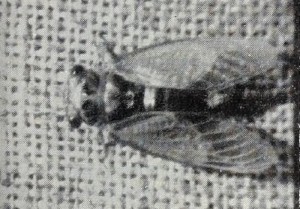
"There is a lively and rewarding sense of participation about Nature Campers which, despite its threatening length, should give this picture wide appeal. In it, an eager-eyed group of young people and a few engagingly raffish naturalists pursue their studies of the outdoors with enthusiasm — and sound cinematics. Birds, butterflies, frogs and fish are among the creatures which come before Herbert Shumway's camera. But they come there, not just in the stiff ultracloseups of the studio, but as a natural part of the picture's development. The background musical selections are an enjoyable addition to an entertaining picture." Movie Makers, Dec. 1951, 412.
Total Pages: 299